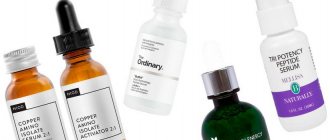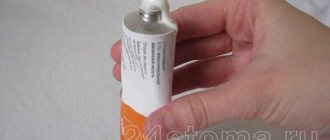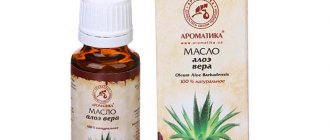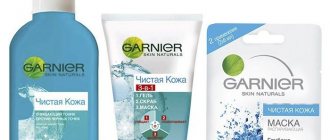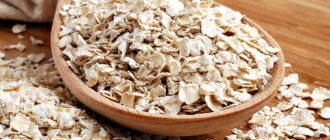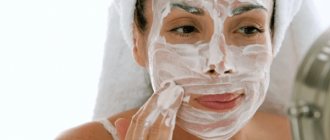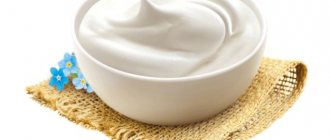It has become easier to buy tretinoin for wrinkles and acne, but this useful cosmetic component raises many questions. How to use it correctly, how to introduce tretinoin into cosmetics and how to rejuvenate the skin at home - that’s what this article will discuss.
The Zulfiya online store was the first in Ukraine to offer tretinoin , the introduction of this component into cosmetics is extremely small, so it is impossible to do without accurate scales. For those who are just thinking about tretinoin rejuvenation, let us remind you that on average a 100-gram tube of cream contains 0.025-0.05% of the active substance. It's very small, but extremely effective! Let's look at this retinol derivative in more detail, but first let's dive into the history of the issue.
The first tretinoin cream in history appeared not so long ago: in 1967, dermatologist Albert Kligman proposed using the emulsion to treat acne vulgaris. The effect pleasantly surprised not only the subjects, but also the doctor himself, who suggested using a cream with retinol and against wrinkles: there was a thickening of the dermis, increased skin turgor, as well as an even healthy tone inherent exclusively in young skin.
Doctors were also interested in the issue of getting used to the drug; it turned out that the dermis does not get used to tretinoin, so the formula can be used for as long as desired. Singer Cher, for example, was one of the first to use retinol cream: first she treated acne with it, and later wrinkles. A universal item!
Tretinoin: peeling, side effects, contraindications
Adverse skin reactions when using standard tretinoin cream or gel are redness or severe dryness of the skin. This is normal; if such a reaction occurs, you should simply adjust the dosage of the cream: dilute it by half with another emulsion. According to cosmetologists, it is wiser and more pleasant to use the lowest dosage of 0.025% than to courageously endure peeling and redness using 0.05%. Tretinoin still works - 0.025% or 0.1%, so don’t mock yourself, listen to how your skin feels.
There is only one contraindication: pregnancy. Forget about tretinoin during the breastfeeding period, you will have enough vitamin C and AHA in your care, they also take excellent care of the skin.
Conclusion
Topical use of tretinoin as an anti-acne agent began almost half a century ago. Since then, it has been successfully used to treat comedonal and inflammatory acne.
Over the years, the beneficial effects of tretinoin have increased due to the understanding of its exceptional properties associated with a growing appreciation for its anti-inflammatory actions. This extensive review of tretinoin's immunomodulatory properties reveals that it has five important comedolytic properties that are considered anti-inflammatory in nature. In more recent times, tretinoin has been combined with antibacterial agents such as erythromycin, benzoyl peroxide and clindamycin to form a combination for topical acne treatment. It has proven to be very effective in treating various stages of acne.
Tretinoin and compatibility with acids, vitamins
The active ingredient tretinoin loses its potency if mixed in one application.
with acids. At different times - please. For the tertiary course, the skin is often prepared with alpha hydroxy acids, but then they do not overlap in care. On the same day, either tretinoin or acid. Or so - retinoids in the evening, acids in the morning.
To enhance the whitening effect of the tertiary, many people mix it with vitamin C. Together they enhance the whitening effect, but you need to try it to see if your skin likes it.
After tretinoin, after half an hour, you can apply a moisturizing treatment - at first this is even welcome. Some people suffice with a moisturizing or vitamin serum (without acids!), while others prefer a soothing mask.
Reviews for Tretinoin
Judging by the reviews, this cream can really help even in cases where other remedies are ineffective.
Olga, 25:
“Pimples don’t bother me much - they appear rarely and go away quickly. But I really don’t like the pits and scars that remain from adolescence, when my whole face was literally covered with inflammation. I also have enlarged pores. I decided to try Tretinoin. Within a month, the skin became smoother, the blackheads were significantly reduced - and most importantly, the scars began to smooth out. I also noticed that the small wrinkle that appeared between my eyebrows has decreased.”
Oksana, 19:
“I have very oily skin, it is constantly inflamed - pimples and blackheads. I got tired of covering it all up with foundation and decided to take a course of treatment with Tretinoin. I finally found a product that helped me! My skin now, after 4 months, is much better - I can finally walk without any concealers, I just breathed a sigh of relief.”
This article is for informational purposes only, please consult your doctor for details!
What is tretinoin combined with in cosmetics?
As practice shows, tretinoin can be combined with anything except acids. But there is one thing - the activity of the cream/gel/lotion is very high even with one ingredient (tretinoin), so it simply does not make sense to complicate the formula with peptides, vitamins or extracts.
The best method of care would be tretinoin at night, and after half an hour - a mask or additional cream (with the actives you need).
The pH of the emulsion or gel to which you plan to add tretinoin should be in the range of 4-6. Tretinoin can be added to oil after being dispersed in polysorbate-80. However, in the case of oil, sediment is possible (which is why the most popular pharmaceutical form is an ointment, thick cream or gel).
Results of a study of tretinoin as an anti-aging agent
In a randomized, parallel, double-blind study, participants used retinol and tretinoin on their skin for three months. After three months, they concluded that wrinkles were much smaller, photodamage and pigmentation were reduced.
The study concluded that tretinoin may work like a magic wand to smooth out wrinkles and remove other signs of aging.
Another double-blind study examined the effects of tretinoin on photoaged skin. The results concluded that daily use of 0.5% tretinoin cream not only increases collagen synthesis, but also improves skin structure and tone, and promotes the formation of new blood vessels.
The first results from the effects of tretinoin may be noticeable only after several weeks of regular use. However, in the long term, major changes will be visible.
The study found that tretinoin improved clinical signs of photoaging in participants, but significant differences were observed after six months of continuous use of the cream. The study was extended for another six months. Participants used the cream 1-3 times a week. The results showed even greater improvements in anti-photoaging performance.
Tretinoin is a potent anti-aging agent. However, it should be used carefully and correctly to get the most out of it.
How to apply tretinoin to the skin?
The active tretinoin product (gel or cream) is applied in a small amount and distributed over the skin. There is an opinion that retinoids are best applied to dry skin, because... Immediately after washing, damp skin may react more strongly to the retinoid. Again, this is individual, try it.
It is better to apply any substance with vitamin A at night: this vitamin is fragile and loses its meaning in the light. Therefore, a tube of tretinoin is usually kept on the night table, and do not forget to smear your hands with it.
Whether to use tretinoin under the eyes is a common question. We recommend applying it, but start with a tiny dosage. It will definitely help with wrinkles and crow’s feet, the main thing is not to overdo it with concentration.
The skin on your body needs the rejuvenating power of tretinoin just as much as your face. Don't forget about the neck, arms, and décolleté, to which retinoids bring health and elasticity.
It is important to note that real skin rejuvenation is observed after 2 years of regular use of tretinoin. It's long, yes, but it's worth it!
Your Zulfiya
Introduction
Acne (acnevulgaris) or acne vulgaris is one of the most common skin diseases in Europe [1] and the most common in the United States [2], affecting more than 80% of adolescents and young adults [1].
In many cases, acne can last for decades [3]. This is a chronic inflammatory disease of the pilosebaceous apparatus, manifested by erythema, edema, discomfort, and scar formation in 43% of patients [4]. As is common with dermatological conditions [5], such symptoms often have psychological and social consequences [6].
Treatment varies depending on the severity, from topical therapy (retinoids, benzoyl peroxide, antibiotics) in mild cases to oral antibiotics, hormonal treatment, and oral isotretinoin in moderate to severe cases.
Current European consensus documents [7] strongly recommend oral isotretinoin for moderate to severe papulopustular/nodular acne at 0.3–0.5 mg/kg/day and acne conglobata at ≥ 0.5 mg/kg/day . Systemic therapy, including isotretinoin, is generally not recommended for mild to moderate papulopustular acne [7,8].
The reported side effects of oral isotretinoin [9,10] have been of concern and are likely to have influenced prescribing patterns. Although subsequent studies and reviews have shown a good safety profile [11], there may still be persistent reluctance to prescribe oral isotretinoin.
Delay in administering adequate treatment can lead to scar formation, which will affect quality of life. There should be no undertreatment of this widespread condition.
We describe our experience with the use of oral isotretinoin in patients with acne vulgaris, drawing on relevant publications covering key points associated with the use of isotretinoin, namely: comparison of oral isotretinoin use with antibiotics, psychological aspects in acne and oral isotretinoin treatment, side effects of oral isotretinoin treatment and aesthetic approaches that can alleviate predictable side effects.
Using isotretinoin or taking antibiotics
Acne treatment must take into account all factors: abnormal keratinization, sebum production, bacterial flora and especially inflammation. Patients should be offered a simple treatment regimen initially to increase adherence [12].
Oral antibiotics are commonly used to treat moderate to severe acne; they should be used in conjunction with topical treatments [13], preferably containing benzoyl peroxide [14].
In recent years, the exponential increase in antibiotic resistance has led to restrictions on antibiotic use—oral antibiotics should be used for no more than 3 months [15].
Accordingly, alternative methods are required [16]. One alternative is oral isotretinoin [17].
According to Peck, oral isotretinoin was effective in the treatment of severe forms of acne and resulted in complete recovery in 13 of 14 patients treated [18].
- The main indications for the use of oral isotretinoin are:
- Severe nodular cystic acne
- Severe papulopustular acne.
- Nodular rashes of moderate to severe severity.
- Insufficient effect on previous treatment.
- Tendency to form scars.
- Sudden relapse after cessation of therapy.
- Patients experiencing severe psychological stress.
More recently, the range of use of oral isotretinoin has been expanded to include mild inflammatory acne that has resulted in scarring or when the patient experiences significant psychological distress. Low doses of isotretinoin are effective against hyperseborrhea and mild inflammatory acne that do not respond to systemic antibiotics due to acquired resistance. Early recognition of non-response to antibiotics is important [19].
Nagler and colleagues conducted a clinical trial at New York University in 137 patients treated with oral isotretinoin between 2005 and 2014, examining systemic antibiotic use in these patients before isotretinoin treatment.
They reported that the mean duration of antibiotic therapy was 331.3 days; 15% of antibiotics were prescribed for 3 months or less, 64% for 6 months or more, and 34% for 1 year or more. The study concluded that early identification of patients who fail to respond to oral antibiotics is important.
It is also strongly recommended that you decide to stop taking antibiotics within 6-8 weeks and consider using isotretinoin.
Our experience and recommendations
For 30 years, we (Piquero et al.[21]) have used isotretinoin at low doses or 0.2–0.3 mg/kg/day for 12 months followed by topical maintenance therapy with excellent response in over 80 % cases with moderate inflammatory acne in patients prone to scar formation.
For severe inflammatory acne, we continue to use the doses recommended in international consensus documents. Based on the literature and our experience, patients should be offered a simple treatment regimen to improve adherence.
The indications for the use of systemic antibiotics and the duration of their use should be limited, especially when effective alternatives are available [22].
Psychological aspects of acne and the role of oral isotretinoin
Acne has a significant impact on the psychological state of most patients with this disease. Mainly in the form of depressive symptoms [23,24].
Oral isotretinoin provides the most effective therapeutic effect for acne, significantly improving symptoms. However, a study published in 1983 stated that oral isotretinoin may cause symptoms of depression [9].
Since then, numerous publications have debated this issue. Those who have found a positive association between isotretinoin and depression have concluded that this is due to an idiosyncratic effect observed in those patients who have a high family history of depression [25,26].
However, most studies have not found an association between oral isotretinoin and depression, but rather have found a positive effect of treatment on reducing depressive symptoms [27–32].
A systematic review and meta-analysis examining the association between oral isotretinoin and depression was published in 2022 [33].
It included 31 controlled or prospective uncontrolled studies involving ≥ 15 patients treated with oral isotretinoin for acne. In total, the work assessed data on 2939 patients. Scores were calculated according to the main depression scales before and at the end of treatment.
The data showed no significant increase in depressive symptoms in patients receiving isotretinoin compared with patients receiving other treatments. Rather, scores close to indicating depression were significantly reduced in patients receiving isotretinoin.
However, a decrease in depression scores was noted from the start of treatment and became low after completion of treatment with oral isotretinoin.
In 2004, we (Guerra-Tapia et al [34]) developed a treatment satisfaction questionnaire that included assessments of depression and anxiety scales before, during and after isotretinoin treatment. Approximately 4,000 patients completed the survey.
All respondents reported significant improvement in psychological status, indicating high compliance with oral isotretinoin treatment. All respondents stated that they would be willing to repeat the course of treatment if necessary in the future.
Our experience and recommendations
Treatment of acne with oral isotretinoin does not appear to be associated with increased depression in most patients. On the contrary, depressive symptoms may improve with isotretinoin therapy [11].
There is only a small proportion of patients who experience increased depression and suicidal thoughts while taking this medication. Given this fact and the increased predisposition of adolescents to depressive conditions, it would be prudent to recommend careful monitoring of all patients with acne to identify those who, due to individual predisposition, are at increased risk of developing depression.
Side effects of oral isotretinoin
Isotretinoin is a physiologically active metabolite of vitamin A (retinol) [35].
Almost all patients treated with oral isotretinoin have a good therapeutic outcome [7,9]; however, it may also have side effects. Most of them, with the exception of teratogenicity, are dose dependent.
A recent Cochrane review [36,31] and a randomized controlled trial of 3836 participants concluded that non-serious side effects were more common with isotretinoin than with oral topical antibiotics, but did not draw any conclusions about serious adverse events. Oral isotretinoin should only be used under the supervision of physicians experienced in the use of systemic retinoids in the treatment of acne and with a thorough understanding of the risks of therapy and monitoring requirements.
Patients may also consult with physicians during treatment with isotretinoin, so patient awareness of possible associated side effects is an important factor in adherence.
Adverse effects can be divided into the following categories: 1) teratogenic, 2) clinical: cutaneous or extracutaneous, and 3) laboratory results.
Oral isotretinoin has also been associated with nonspecific side effects affecting various body systems, but these are usually sporadic cases, the clinical significance of which appears to be negligible compared to the sum of all isotretinoin exposures. In addition, it is likely that there is a tendency to overestimate the frequency and severity of side effects in leaflets, as is often the case with other drugs [37].
Teratogenicity
This is the most important side effect [38].
Ingestion of isotretinoin by women of childbearing potential, regardless of dose, can cause serious fetal malformations, premature birth, or spontaneous abortion in a high percentage of cases.
Pregnancy prevention programs (PPPs) in their various forms [39,40] have generally been successful, since unintended pregnancies during treatment with oral isotretinoin, although occurring in small numbers. Female patients undergo laboratory pregnancy testing before starting treatment, then monthly at the beginning of each menstrual cycle during treatment and one month after treatment ends.
They receive detailed oral and written information about isotretinoin treatment in general and contraceptive methods in particular. The use of contraception should begin one month before the start of treatment and continue throughout treatment and one month after stopping treatment. Unfortunately, there is evidence of unsuccessful and ineffective PPPs[41].
Therefore, it is critical that patients receive accurate information and stay in touch with their doctor. In addition, two recent articles highlight unintended circumstances that may result in delayed initiation of therapy or premature discontinuation of treatment, especially in certain populations [42,43].
In 2022, the European Medicines Agency published a review on systemic retinoids, highlighting the need for updated pregnancy prevention measures [44].
Skin side effects
Side effects such as dry skin and mucous membranes are very common. Moreover, their absence may raise the question of insufficient dosage. Xerosis occurs secondary to pharmacologically induced sebum suppression [45] and epidermal dyscohesion (?) [4,6,47].
The most common clinical side effect is cheilitis (Fig. 1), dry lips, which can vary from xerosis to painful fissures [48].
The degree of skin dryness and flaking depends on the dose. These symptoms are often observed in areas with the largest number of sebaceous glands, namely the face, chest and back. Dryness of the mucous membranes of the nose and eyes may also occur when taking too high doses. Severe skin reactions (eg, erythema multiforme, Stevens-Johnson syndrome, and toxic epidermal necrolysis) have been observed very rarely [49].
Some patients experience initial worsening of acne in the first month of treatment; less commonly, isotretinoin can cause fulminant acne [50]. This is likely due to the dose of isotretinoin being too high for this patient.
Extradermal side effects
During treatment, headache, fatigue and visual disturbances may occur, including night vision disturbances, keratitis and corneal opacities. These complications may be dose-dependent. Benign intracranial hypertension has been reported when isotretinoin is used together with certain antibiotics [51].
Gastrointestinal disorders associated with colitis and inflammatory bowel disease may also occur during isotretinoin treatment, but a precise cause-and-effect relationship has not been established [52,53].
Indeed, meta-analyses found no association between an increased risk of IBD and isotretinoin use [54]. Psychiatric side effects of oral isotretinoin are discussed elsewhere in this article.
Changes in laboratory tests
Lipids: Oral isotretinoin may cause a dose-dependent increase in blood cholesterol and triglyceride levels. A large meta-analysis [53] on this topic found that oral isotretinoin was associated with a statistically significant change in the mean of these parameters, but the mean increase did not meet high-risk criteria.
In addition, the proportion of patients with such laboratory abnormalities was low enough that it was concluded that monthly testing (as indicated in the drug instructions) was not necessary. Laboratory tests are recommended before starting treatment, after 6 weeks, and then every 3 months during therapy [56].
If hypertriglyceridemia cannot be controlled, oral isotretinoin should be discontinued.
Liver transaminases may also increase in a dose-dependent manner during treatment. It should be kept in mind that there are many possible causes of elevated transaminase levels and these should be ruled out. In a recent review, the increase in transaminases due to oral isotretinoin was determined to be transient and usually not requiring discontinuation of treatment [57].
Transaminases should be checked before treatment, after 6 weeks, and then every 3 months (early testing is required only if clinically necessary).
Creatinine phosphokinase (CPK) is a muscle enzyme whose levels physiologically increase during exercise. Oral isotretinoin is considered another possible inducer of this enzyme (dose-dependent).
There are few clinical studies on the relationship between CPK and oral isotretinoin, and most published articles are only case reports [58]. The prevalence of elevated CPK levels ranges from 10% to 50% [58].
However, this fact must be assessed individually for each patient. Moderate exercise is a known cause of elevated CPK levels.
Muscle symptoms are sometimes reported, but evidence of muscle damage is very rarely found [10,58].
Rare cases of bone changes have been observed, but these have been associated with very high dosage of isotretinoin, long duration of treatment and overall high cumulative dose [59–62].
Monitoring for abnormalities in CBC parameters is not of great importance since abnormalities occur infrequently and are unlikely to affect treatment [63].
Our experience and recommendations
The correct dosage is critical when taking oral isotretinoin. Each patient has individual characteristics regarding drug absorption, bioavailability and side effects.
In addition, dermatologists should be aware of differences in the production of the active substance and the widespread availability of oral isotretinoin analogues. The literature shows that a low starting daily dose of 0.1–0.2 mg/kg/day or about 10 mg per day and gradually increasing to the maximum tolerated dose is the best way to obtain good clinical results while minimizing side effects compared with the standard dose 0.5 mg/kg/day [64].
All medications can cause side effects. Obviously, the balance between clinical effectiveness and side effects must be tilted towards the former.
A review of the effectiveness and side effects of oral isotretinoin, including only randomized control trials involving 760 patients, found that only 12 patients discontinued treatment due to side effects [49].
Oral isotretinoin is undoubtedly the most effective drug for treating severe forms of acne that do not respond to other treatments.
It is sometimes incorrectly described as a dangerous drug, without pointing out that the only real concern is teratogenicity in patients of childbearing age.
Cosmetological aspects
Cosmetic treatment of acne is of great importance and should also be recommended to patients [65]. Naturally, patients want to get good therapeutic results in the shortest possible time.
Oral isotretinoin, which is so useful in the treatment of acne, affects the skin barrier function, lipids, sebaceous glands and skin microflora. Cosmetic treatments and general recommendations help reduce side effects, thereby promoting adherence to treatment, which contributes to better therapeutic efficacy and a better quality of life for patients [66].
In dermatology in general and especially in acne, dermatocosmetics are very important. Dermatocosmetics helps to minimize the side effects of pharmacological treatment [67].
Numerous studies have shown that adherence to acne medications is particularly low when a person is prescribed a combination of topical and systemic treatments [3,68].
It is important to begin using dermocosmetics early in treatment with oral isotretinoin to minimize side effects and improve adherence. Dermatocosmetics should be selected according to their constituent ingredients to suit the specific needs of the patient.
Oral isotretinoin is associated with the following structural and functional changes in the skin: [46,69]
Modified barrier function
Xerosis, fissures and eczema are common side effects associated with impaired skin barrier function. As a consequence, there is an imbalance between moisture loss and retention (permeability barrier), decreased recognition and neutralization of microbes (antimicrobial barrier), and loss of the antioxidant barrier.
Consequently, there is an increased risk of sun exposure (sunscreen barrier) and altered response to exogenous allergens and haptens (immune barrier) [46].
Corneocyte decohesion
Oral isotretinoin causes increased epidermal turnover and “fragility” of the skin, which makes it sensitive to intradermal “separation”.
There is a loss of contact between desmosomes and a decrease in the number of tonofibrils. Corneocytes are easily separated from the outer part of the stratum corneum, which explains the desquamation that patients experience.
In addition, depending on the dose of isotretinoin, transepidermal water loss (TEWL) increases [70]. These changes trigger a cycle of inflammation, the release of inflammatory cytokines, which contribute to hyperproliferation of the epidermis and the appearance of hyperkeratosis [46,71].
In 2007, we (Herane et al) conducted a prospective, double-blind, placebo-controlled study [72] of adjuvant therapy with oral isotretinoin (0.4–0.7 mg/kg) using a specific moisturizing gel cream containing the active substances , including biosaccharide gum(?) (from the English biosaccharide gum-2), hyaluronic acid and glycerin.
After one month of treatment, compared with the placebo group, the adjuvant group had 19% higher hydration levels and lower TEWL (barrier effect) levels than the isotretinoin-only group.
Changes in lipid composition
It is important to distinguish between lipids that are physiologically integrated into the intercellular lipid membrane (ILM) and sebum-derived lipids that are secreted in the follicular duct and “flow” to the skin surface. Studies in mice have shown that isotretinoin does not alter ILM [46,70].
The sebum suppression effect of oral isotretinoin (at the recommended total dose of 100–120 mg/kg) begins after one month of treatment. The reverse effect begins approximately 4-5 months after completion of treatment.
At week 6 of treatment with oral isotretinoin, a change in lipid composition begins with a decrease in the proportion of glycerides (by 36%), an increase in free stearins (34%) and total ceramides (19%), as well as an increase in the ratio of free stearins: in particular cholesterol (86%) [ 73].
Cholesterol increases by 10–25%, and the proportion of waxy esters and squalene decreases [45,46]. This leads to a decrease in comedogenesis and the number of comedones [71,74].
Skin microflora
Oral isotretinoin causes changes in the type and number of microorganisms that colonize the skin and nasal mucosa, with increased colonization by Staphylococcus aureus and a marked decrease in the number of Propionibacterium acnes from the beginning of treatment, and which continues for some time after the end of treatment [75].
Our experience and recommendations
Appropriate care for acne-prone skin while taking retinoids includes gentle cleansing, restoring the skin barrier, and maintaining barrier function [72].
For cleansing, you should use soft special products, cleansing emulsions or micellar lotions [66].
The use of abrasive cleansers and products containing sulfur, glycolic acid or similar substances should be avoided. Moisturizers and emollients should be non-comedogenic, hypoallergenic, non-irritating, non-greasy, and water-based [76].
It is very important to use special moisturizers that contain active ingredients of high quality and concentration to protect and restore the skin. Products with hyaluronic acid, glycerin, biosaccharides, oligosaccharides, etc. are suitable. [72,77].
During periods of high sun exposure, especially in countries with a thinning ozone layer, dermatitis, eczema, cheilitis and other signs of sun sensitivity often occur on areas exposed to light: mainly the face and hands.
In this case, you should use an SPF 50+ UVA/UVB sunscreen that has been specifically tested to be comedogenic for oily, acne-prone skin. E
It must be applied every 2 hours, as well as after swimming or after heavy sweating. For lips and mucous membranes, it is recommended to use Vaseline at night and lip balms with an SPF 30–50 filter several times a day.
Eye drops and gels are especially useful for patients who wear contact lenses or live in areas with high levels of air pollution. You should also wear sunglasses at night, especially in the summer and when participating in any outdoor activities.
When it comes to hair removal, cold wax or razors are preferable to hot wax or lasers, followed by moisturizer and sun protection. Hair removal using intense pulsed light (IPL) must be done with caution.
There is controversy regarding procedures such as dermabrasion, chemical abrasives, CO2 laser, and fractional radiotherapy.
Some practitioners delay such procedures for more than 6 months [55] after stopping oral isotretinoin, while others wait 20 to 30 days (the time it takes for the drug to clear).
Two recent reviews [78,79] do not recommend mechanical dermabrasion and ablative laser [78].
However, there is still insufficient evidence to support delaying microdermabrasion, superficial chemical peels, fractional ablative and fractional non-ablative laser resurfacing for patients who are currently taking or have recently taken isotretinoin (6–12 months) [78,79].
Our current practice is to wait approximately 2 months after stopping isotretinoin before starting such procedures. Thus, the use of special cosmetics increases treatment adherence by 2.2 times with a noticeable reduction in side effects [66].
conclusions
Acne significantly affects the psychological state of patients, often manifesting itself in the form of depressive symptoms. Timely effective treatment not only helps to minimize the risk of permanent scarring, but also helps with psychological aspects.
Therefore, there is an improvement in the patient’s quality of life. Appropriate cosmetic treatment should be considered alongside primary pharmacological treatment to reduce side effects and promote treatment adherence, thereby showing improved results.
Oral isotretinoin is an important part of the treatment of acne. This drug has truly changed the lives of patients.
The most serious side effect is teratogenicity, so compliance with existing pregnancy prevention programs is of paramount importance, regardless of isotretinoin dosage.
Other side effects can be easily prevented and/or treated in the vast majority of cases. Oral isotretinoin, when used correctly, can be considered a reasonable alternative to antibiotics.
